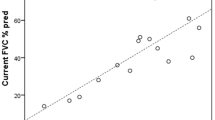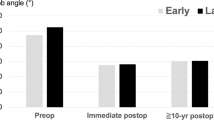Abstract
Study Design
The current literature on outcomes of early fusions for early-onset scoliosis (EOS) has a short follow-up of 7.7 to 12.5 years, with many patients not at the end of growth. The forced vital capacity (FVC) at follow-up ranged from 40.8% to 64% of predicted. A study was undertaken to evaluate the long-term outcome of these fusions.
Methods
The study is of congenital patients who had a fusion under age 8 years, with the current age being >20 years. A follow-up consisting of radiographs, outcome questionnaires, and pulmonary function tests was performed. Of the 42 patients identified, 20 were traced and 11 agreed to participate, and completed all the data. The average follow-up was 37 years. All the fusions included the thoracic spine, with an average of 10.2 levels fused, of which an average of 8.8 levels were thoracic.
Results
The average scoliosis at presentation was 52°, 56° at surgery and 47° at follow-up. At follow-up, the average FVC was 53% of predicted, with an average PaO2 of 86 and PaCO2 of 44 mm Hg. The mean T1–T12 length was 20 cm. There was no correlation of the FVC percentage predicted and the proximal extent of the fusion, the T1–T12 length or the number of thoracic levels fused. The average ODI was 23. On the SF36, the average Physical Component t score was 50; with the average Mental Component t score was 52.
Conclusion
At a long-term average follow-up of 37 years, the patients had a low FVC of 53%, with one on permanent oxygen and 5 with dyspnea. The patients were functioning well at follow-up, but it is unknown what their function would be without surgery or with longer follow-up.
Similar content being viewed by others
References
Campbell R, Smith M, Mayes T, et al. The characteristics of thoracic insufficiency syndrome associated with fused ribs and congenital scoliosis. J Bone Joint Surg Am 2003;85:399–408.
Akbarnia B, Breakwell L, Marks D, et al; Growing Spine Study Group. Dual growing rod technique followed for three to eleven years until final fusion: the effect of frequency of lengthening. Spine 2008;33:984–90.
Garrido E, Tome-Bermejo F, Tucker S, et al. Short anterior instrumented fusion and posterior convex noninstrumented fusion of hemivertebra for congenital scoliosis in very young children. Eur Spine J 2008;17:1507–14.
Hasler C, Mehrkens A, Hefti F. Efficacy and safety of VEPTR instrumentation for progressive spine deformities in young children without rib fusions. Eur Spine J 2010;19:400–8.
McCarthy R, Sucato D, Turner J, et al. Shilla growing rods in a caprine animal model: a pilot study. Clin Orthop Relat Res 2010;468:705–10.
Motoyama E, Yang C, Deeney V. Thoracic malformation with early-onset scoliosis: effect of serial VEPTR expansion thoracoplasty on lung growth and function in children. Paediatr Respir Rev 2009;10:12–7.
Yang J, McElroy M, Akbarnia B, et al. Growing rods for spinal deformity: characterizing consensus and variation in current use. J Pediatr Orthop 2010;30:264–70.
Yazici M, Emans J. Fusionless instrumentation systems for congenital scoliosis: expandable spinal rods and vertical expandable prosthetic titanium rib in the management of congenital spine deformities in the growing child. Spine 2009;34:1800–7.
Goldberg C, Gillic I, Connaughton O, et al. Respiratory function and cosmesis at maturity in infantile-onset scoliosis. Spine 2003;28:2397–406.
Emans JK. Outcome after spinal fusion of 4 or more thoracic spinal segments before age 5. Paper presented at: Scoliosis Research Society Annual Meeting, Buenos Aires, 2004, Paper 101.
Karol L, Johnston C, Mladenov K, et al. Pulmonary function following early thoracic fusion in non- neuromuscular scoliosis. J Bone Joint Surg Am 2008;90:1272–81.
Vitale M, Matsumoto H, Bye M, et al. A retrospective cohort study of pulmonary function; radiographic measures; and quality of life in children with congenital scoliosis. An evaluation of patient outcomes after early spinal fusion. Spine 2008;33: 1242–9.
Nachemson A. A long term follow-up study of non-treated scoliosis. Acta Orthop Scand 1968;39:466–76.
Pehrsson K, Larsson S, Oden A, Nachemson A. Long-term follow-up of patients with untreated scoliosis. A study of mortality; causes of death; and symptoms. Spine 1992;17:1091–6.
Owange-Iraka J, Harrison A, Warner J. Lung function in congenital and idiopathic scoliosis. Eur J Pediatr 1984;142:198–200.
Muirhead A, Conor A. The assessment of lung function in children with scoliosis. J Bone Joint Surg Br 1985;67:699–702.
Bowen R, Scaduto A, Banuelos S. Does early thoracic fusion exacerbate preexisting restrictive lung disease in congenital scoliosis patients? J Pediatr Orthop 2008;28:506–11.
Goldberg C, Fallon M, Moore D, et al. Growth patterns in children with congenital vertebral anomaly. Spine 2002:271191–201.
Dimeglio A, Bonnel F. Spine Growth [in French]. Berlin: Springer; 1990.
Karol L. Early definitive spinal fusion in young children: what we have learned. Clin Orthop Relat Res 2011;469:1323–9.
Author information
Authors and Affiliations
Corresponding author
Additional information
Author disclosure: JEL (reports other from Zimmer/Biomet, outside the submitted work).
Supported in part by a Research grant from the SRS.
Rights and permissions
About this article
Cite this article
Lonstein, J.E. Long-term Outcome of Early Fusions for Congenital Scoliosis. Spine Deform 6, 552–559 (2018). https://doi.org/10.1016/j.jspd.2018.02.003
Received:
Revised:
Accepted:
Published:
Issue Date:
DOI: https://doi.org/10.1016/j.jspd.2018.02.003




